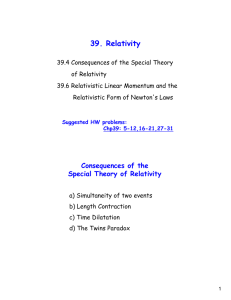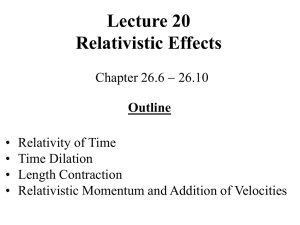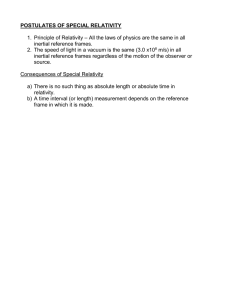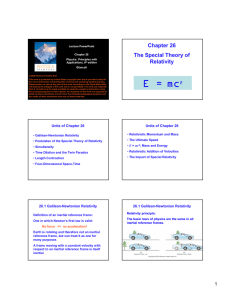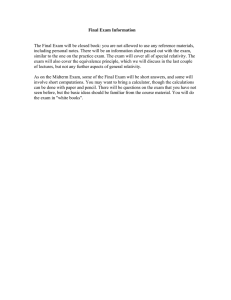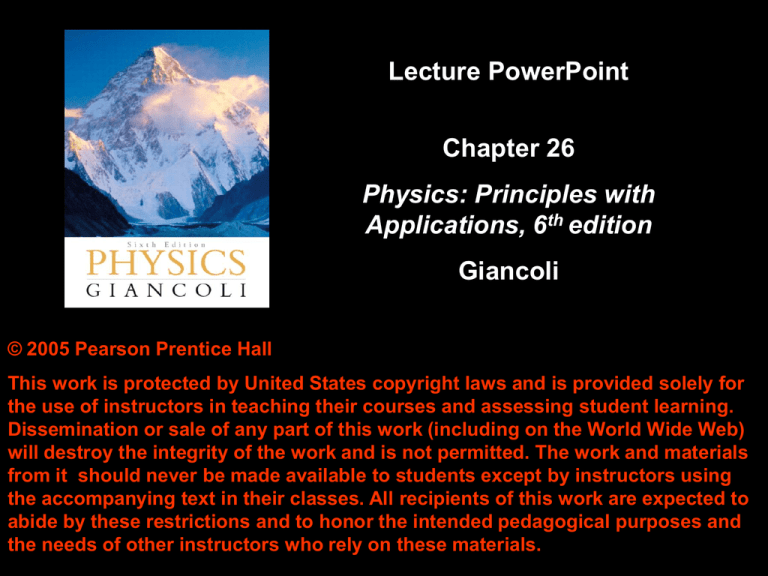
Lecture PowerPoint
Chapter 26
Physics: Principles with
Applications, 6th edition
Giancoli
© 2005 Pearson Prentice Hall
This work is protected by United States copyright laws and is provided solely for
the use of instructors in teaching their courses and assessing student learning.
Dissemination or sale of any part of this work (including on the World Wide Web)
will destroy the integrity of the work and is not permitted. The work and materials
from it should never be made available to students except by instructors using
the accompanying text in their classes. All recipients of this work are expected to
abide by these restrictions and to honor the intended pedagogical purposes and
the needs of other instructors who rely on these materials.
Chapter 26
The Special Theory of
Relativity
E = mc
2
Units of Chapter 26
• Galilean-Newtonian Relativity
• Postulates of the Special Theory of Relativity
• Simultaneity
• Time Dilation and the Twin Paradox
• Length Contraction
• Four-Dimensional Space-Time
Units of Chapter 26
• Relativistic Momentum and Mass
• The Ultimate Speed
• E = mc2; Mass and Energy
• Relativistic Addition of Velocities
• The Impact of Special Relativity
26.1 Galilean-Newtonian Relativity
Definition of an inertial reference frame:
One in which Newton’s first law is valid
Earth is rotating and therefore not an inertial
reference frame, but can treat it as one for
many purposes
A frame moving with a constant velocity with
respect to an inertial reference frame is itself
inertial
26.1 Galilean-Newtonian Relativity
Relativity principle:
The basic laws of physics are the same in all
inertial reference frames.
26.1 Galilean-Newtonian Relativity
This principle works well for mechanical
phenomena.
However, Maxwell’s equations yield the
velocity of light; it is 3.0 x 108 m/s.
So, which is the reference frame in which light
travels at that speed?
Scientists searched for variations in the speed
of light depending on the direction of the ray,
but found none.
26.2 Postulates of the Special Theory of
Relativity
1. The laws of physics have the same form in
all inertial reference frames.
2. Light propagates through empty space with
speed c independent of the speed of source
or observer.
This solves the problem – the speed of light is
in fact the same in all inertial reference
frames.
26.3 Simultaneity
One of the implications of relativity theory is
that time is not absolute. Distant observers do
not necessarily agree on time intervals
between events, or on whether they are
simultaneous or not.
In relativity, an “event” is defined as occurring
at a specific place and time.
26.3 Simultaneity
Thought experiment: Lightning strikes at two
separate places. One observer believes the
events are simultaneous – the light has taken
the same time to reach her – but another,
moving with respect to the first, does not.
26.3 Simultaneity
Here, it is clear that if one observer sees the
events as simultaneous, the other cannot,
given that the speed of light is the same for
each.
26.4 Time Dilation and the Twin Paradox
A different thought experiment, using a clock consisting of
a light beam and mirrors, shows that moving observers
must disagree on the passage of time.
26.4 Time Dilation and the Twin Paradox
Calculating the difference between clock
“ticks,” we find that the interval in the moving
frame is related to the interval in the clock’s
rest frame:
(26-1a)
26.4 Time Dilation and the Twin Paradox
This means:
If an observer looks at the passage of time in
a moving reference frame (moving relative to
the observer’s reference frame), it will appear
to run slower.
This is called “time dilation”.
26.4 Time Dilation and the Twin Paradox
The factor multiplying t0 occurs so often in
relativity that it is given its own symbol, γ.
(26-2)
We can then write:
(26-1b)
26.4 Time Dilation and the Twin Paradox
To clarify:
• The time interval in the frame where two
events occur in the same place is Δt0.
• The time interval in a frame moving with
respect to the first one is Δt.
26.4 Time Dilation and the Twin Paradox
26.4 Time Dilation and the Twin Paradox
It has been proposed that space travel could
take advantage of time dilation – if an
astronaut’s speed is close enough to the
speed of light, a trip of 100 light-years could
appear to the astronaut as having been much
shorter.
The astronaut would return to Earth after
being away for a few years, and would find
that hundreds of years had passed on Earth.
26.4 Time Dilation and the Twin Paradox
This brings up the twin paradox – if any inertial
frame is just as good as any other, why doesn’t
the astronaut age faster than the Earth
traveling away from him?
The solution to the paradox is that the
astronaut’s reference frame has not been
continuously inertial – he turns around at some
point and comes back.
26.5 Length Contraction
If time intervals are different in different
reference frames, lengths must be different
as well. Length contraction is given by:
(26-3a)
or
(26-3b)
Length contraction occurs only along the
direction of motion.
26.4 Time Dilation and the Twin Paradox
This means:
If an observer looks at the length of an object
in a moving reference frame (moving relative
to the observer’s reference frame), it will
appear to be shorter in the direction of motion
than if it was measured at rest.
This is called “length contraction”.
26.6 Four-Dimensional Space-Time
Space and time are even more intricately
connected. Space has three dimensions,
and time is a fourth. When viewed from
different reference frames, the space and
time coordinates can mix.
26.7 Relativistic Momentum and Mass
Expressions for momentum and mass also
change at relativistic speeds.
Momentum:
(26-4)
Gamma and the rest mass are sometimes
combined to form the relativistic mass:
(26-5)
26.8 The Ultimate Speed
A basic result of special relativity is that
nothing can equal or exceed the speed of light.
This would require infinite momentum – not
possible for anything with mass.
26.9 E = mc2; Mass and Energy
At relativistic speeds, not only is the
formula for momentum modified; that for
energy is as well.
The total energy can be written:
(26-7b)
Where the particle is at rest,
(26-8)
26.9 E = mc2; Mass and Energy
Combining the relations for energy and
momentum gives the relativistic relation
between them:
(26-10)
26.9 E = mc2; Mass and Energy
All the formulas presented here become the
usual Newtonian kinematic formulas when the
speeds are much smaller than the speed of
light.
There is no rule for when the speed is high
enough that relativistic formulas must be
used – it depends on the desired accuracy of
the calculation.
26.10 Relativistic Addition of Velocities
Relativistic velocities cannot simply add;
the speed of light is an absolute limit. The
relativistic formula is:
(26-11)
26.11 The Impact of Special Relativity
The predictions of special relativity have been
tested thoroughly, and verified to great
accuracy.
The correspondence principle says that a more
general theory must agree with a more
restricted theory where their realms of validity
overlap. This is why the effects of special
relativity are not obvious in everyday life.
Summary of Chapter 26
• Inertial reference frame: one in which
Newton’s first law holds
• Principles of relativity: the laws of physics are
the same in all inertial reference frames; the
speed of light in vacuum is constant regardless
of speed of source or observer
• Time dilation:
Summary of Chapter 26
• Length contraction:
• Gamma:
Summary of Chapter 26
• Relativistic momentum:
• Relativistic mass:
Summary of Chapter 26
• Mass-energy relation:
• Kinetic energy:
• Total energy:
Summary of Chapter 26
• Relationship between energy and
momentum:

